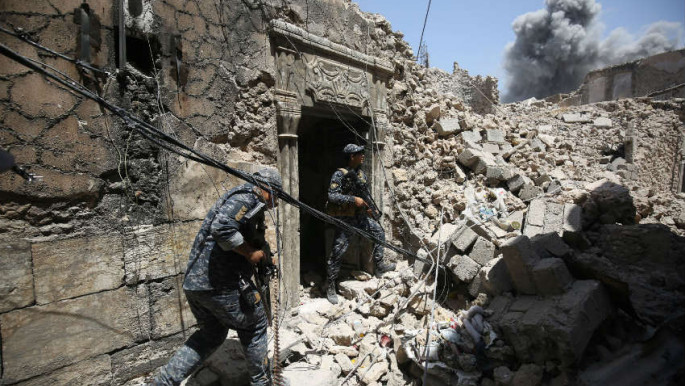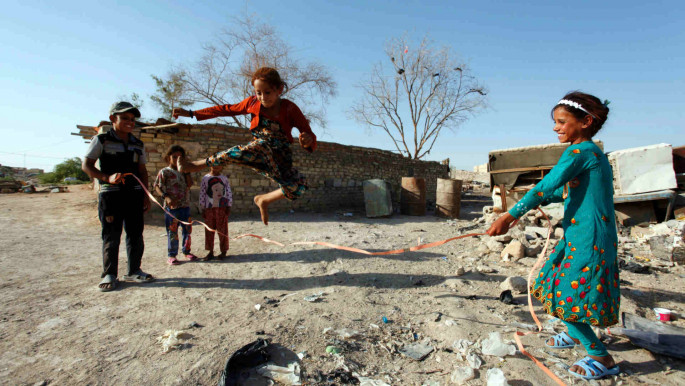The Iraq Report: Attacks on Sunnis threaten to reinvigorate IS
Click here to receive The Iraq Report each week in your inbox
As the third anniversary of the Islamic State group’s “caliphate” looms, Baghdad has yet to defeat the Sunni extremists. IS continues to put up a dogged resistance, and has again demonstrated that it is far from a defeated force, even with the impending loss of Mosul which has suffered potentially irreversible damage as yet more of its heritage is wiped out.
While Iran and the United States compete with each other in several geopolitical arenas, there are now further indications that both nations’ interests converge on the common ground of Iraq. Washington continues to back the Baghdad government, which has been heavily influenced by Iran-backed Shia Islamist political groups, as well as sectarian militant organisations such as the Popular Mobilisation Forces (PMF). This all comes at the expense of true reform in Baghdad, potentially leaving the symptoms that lead to the rise of IS untreated.
A millennium of Mosul’s history destroyed
Not long before an exuberant Prime Minister Haider al-Abadi yet again declared on the eve of Eid that Mosul would be recaptured “within days”, the city of Mosul was struck a devastating blow from which it may never fully recover.
The city’s iconic Grand Nuri Mosque and its “hunchback” minaret that lends the historical city its nickname of Hadba’ was completely destroyed last Wednesday. According to conflicting reports and traded accusations, the Grand Nuri was either destroyed by IS demolition charges, by the US-led coalition or by Iraqi bombardment.
Social media accounts linked to the Iraqi government released a video showing a television monitor displaying what appeared to be night vision camera footage of a mosque minaret being demolished after being rigged to blow. In response, IS’ Amaq news agency released footage on social media the morning after the attack, showing what appeared to be rocket and artillery munition shrapnel at the site of the mosque.
The Iraqi account has been put into further doubt by statements released by government officials. In response to an exposé on alleged Iraqi government war crimes, Iraqi officials made appearances on international television outlets defending the military, saying their soldiers filmed operations in order to provide greater transparency and to prevent war crimes and human rights abuses from occurring.
However, no footage has yet been released by the authorities, despite Iraqi soldiers being approximately 50 metres away at the time. Instead, the only footage that has been released following the destruction of one of Iraq’s most historic sites shows Shia militants celebrating with General Abdulwahhab al-Saidi on the rubble of the mosque, singing that they had “slammed” the Grand Nuri Mosque, using a colloquialism that could suggest that Baghdad had shelled the complex.
This is, however, not evidence that proves complicity beyond doubt, and the circumstances around the mosque’s destruction remain shrouded in mystery.
 |
| Iraqi federal police in a gunfight with IS militants in Mosul's Old City, June 28 [AFP] |
Political process threatened by Shia extremists
Analysts have warned that the destruction of the Grand Nuri Mosque could act as a potent recruitment tool for IS extremists, who will likely claim that Sunni identity is under threat by the Shia-dominated government. This may not be the only factor contributing to a potential continuation of the sectarian strife in Iraq.
On Saturday, parliamentary speaker and senior Iraqi Islamic Party (IIP) lawmaker Saleem al-Jubouri, told The New Arab that his party and other Sunni opposition groups would be holding a “reconciliation conference” in Baghdad in the middle of July. The purpose of the conference, according to Jubouri, would be to reconcile the Sunnis supportive of the political process with the Shia-dominated authorities, and it enjoyed US, UN and regional Arab support.
This declaration infuriated Shia Islamist militants, who vowed to “level” the conference and its attendees. The Iran-aligned militants threatened on Monday to apprehend Sunni politicians who attempted to attend the conference from abroad, including those coming from Jordan, Turkey and other neighbouring countries with large Iraqi diaspora and dissident populations.
Though there are many cross-sectarian opposition groups in exile who oppose what they see as a US- and Iran-instigated political process that they say has subverted Iraqi sovereignty since 2003, parties including the IIP and those controlled by Osama al-Nujaifi, Saleh al-Mutlag and others have long been ardent supporters of the political process. As a result, many of these figures have been rewarded with government posts within the Green Zone.
Nevertheless, this has rarely placated Baghdad’s dominant Shia Islamists. Former Vice-President Tariq al-Hashimi – a former IIP leader – was forced to flee the country in 2011 after then-Prime Minister Nouri al-Maliki attempted to have him arrested on what many believe to be politically motivated terrorism charges. He was subsequently sentenced to death in absentia, and has now largely been excised from the domestic Iraqi political scene.
With IS attacks on the rise in western Iraq, leading to an increased US troop presence and military engagement, there are fears that the symptoms that led to the rise of IS will persist. IS are now also extensively striking economic targets, including electricity pylons and oil pipelines, showing that they are already adapting to the requirements of guerrilla warfare and shifting away from attempting to hold territory. By alienating Sunni Arabs further, Baghdad risks failing to tackle IS.
 |
| Children play in a junkyard in Najaf on the second day of Eid celebrations [AFP] |
Customary ‘Death to America’ missing from Quds Day
The Shia-dominated PMF, or Hashd al-Sha’abi in Arabic, is also further demonstrating its power in the Iraqi capital. As the Iran-inaugurated “Quds Day” demonstrations took place in Tehran and Baghdad on Friday, the Tehran-backed PMF took to the streets to show off their military hardware.
Although it is customary to chant “Death to America!” and “Death to Israel!” while burning the flags of both as a sign of protest against the occupation of Palestine, the former was notably missing from the parade. Instead, only Israeli flags were set ablaze, with threats directed towards the “Zionist entity” rather than the “Great Satan”, as America is customarily dubbed by Shia Islamist groups linked to Iran.
This has been a notable trend in Iraq over the past three years, as the United States has become increasingly instrumental in propping up Baghdad and Iranian proxies in the country. While Tehran and Washington differ in other strategic theatres, in Iraq they appear to have worked together extensively to provide economic, political and military support to the Green Zone. This led to Arab media commentators questioning in 2015 how Iran-backed groups justified receiving air support from the “Great Satan” in their operations against IS.
As a further sign of US support for the Iraqi authorities, Secretary of State Rex Tillerson was reported on Saturday as moving forward in efforts to remove Iraq from a blacklist of states that recruit child soldiers. Tillerson’s decision to whitelist Iraq is apparently at odds with the advice given to him by State Department officials, as Iraq had reportedly not yet done enough to prevent children from being recruited by militant organisations, including the PMF, who are now officially part of the Iraqi armed forces.
International human rights organisations, including Human Rights Watch, said that Tillerson’s decision “undermines US law”, and highlighted State Department reports that concluded at least a dozen children had been killed fighting with a Baghdad-affiliated militia in 2016.
According to US law, the State Department is required under the Child Soldiers Prevention Act to annually identify and list governments that recruit or use child soldiers, HRW said. The New York-based NGO further confirmed that government PMF militants “have recruited and used children to fight Islamic State forces”. Despite this, former President Barack Obama introduced a waiver that allowed military support totalling $3 billion to be sent to Baghdad in 2016 alone, which HRW said undermined both the law and the rights of children.
Children may be paying the price of the United States and Iran continuing to find common ground in Iraq, which also comes at the expense of cross-sectarian political reconciliation efforts. This may not only doom the political process to failure, but could also act as a catalyst to reviving IS or perhaps creating even more destructive organisations in the future.
Click here to receive The Iraq Report each week in your inbox





 Follow the Middle East's top stories in English at The New Arab on Google News
Follow the Middle East's top stories in English at The New Arab on Google News


